Electromotive Force BY Aitkul Asemgul
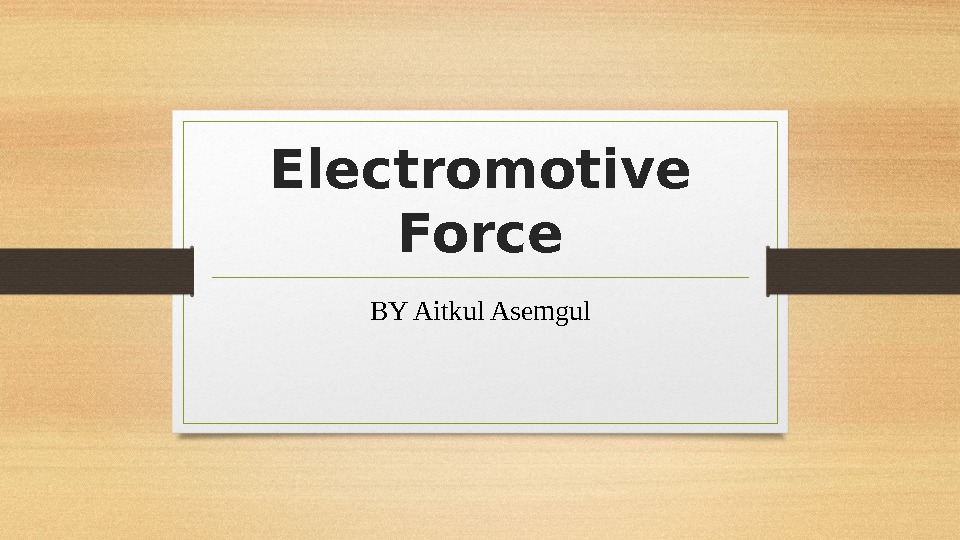
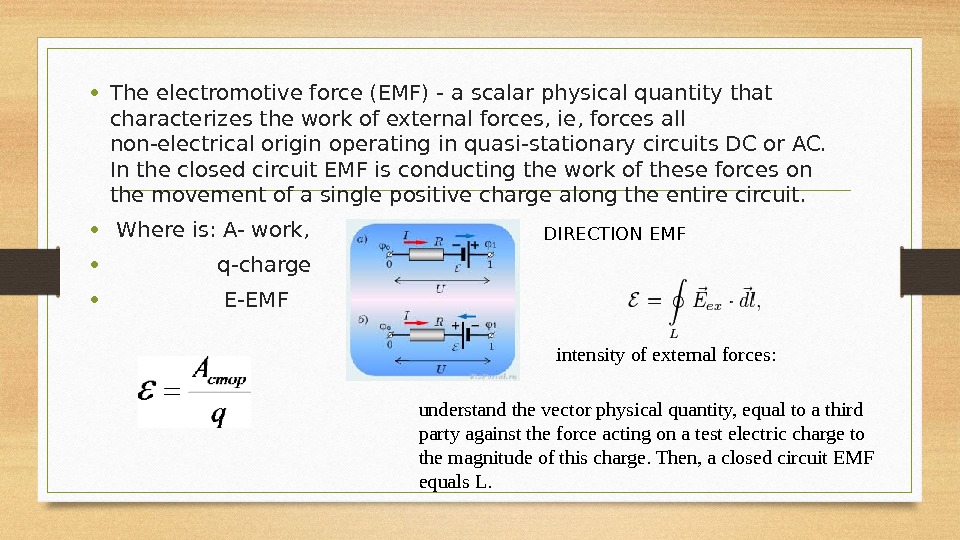
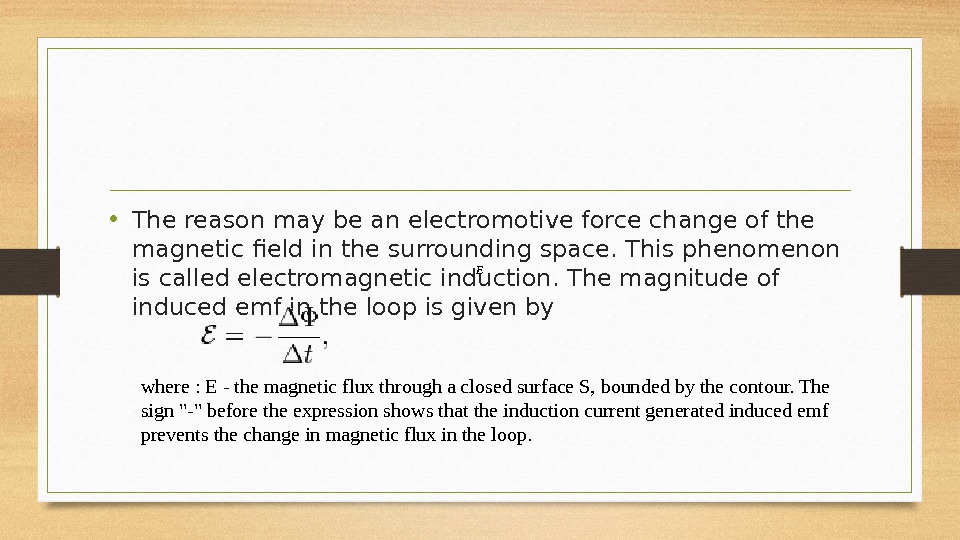
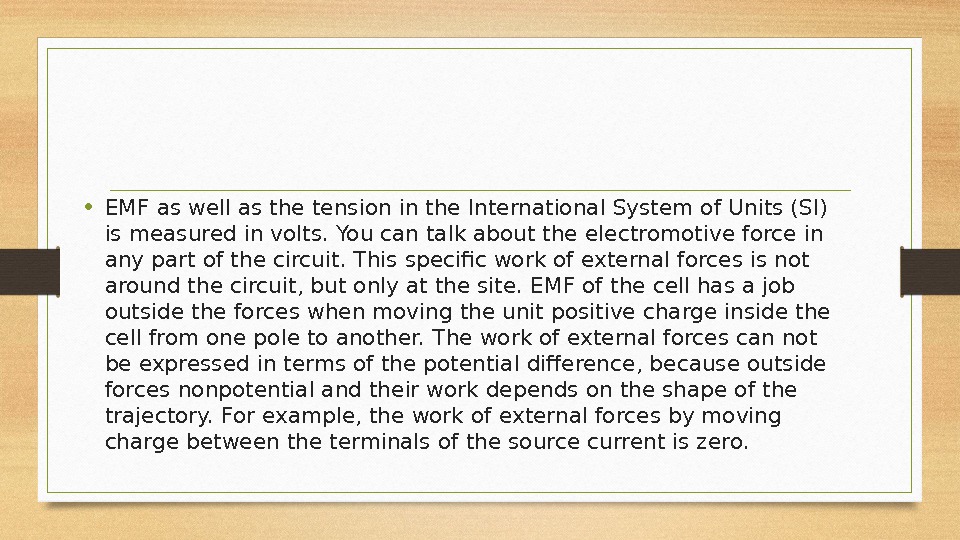
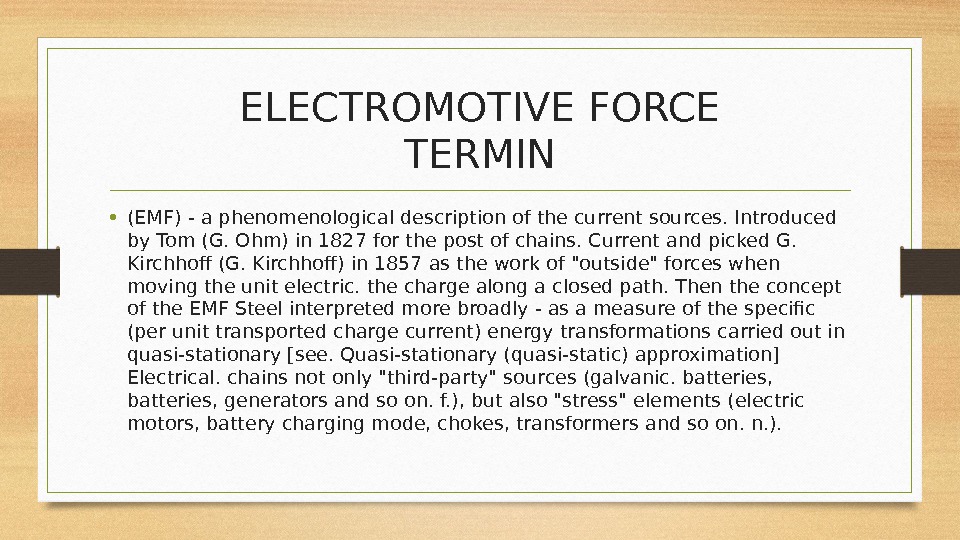
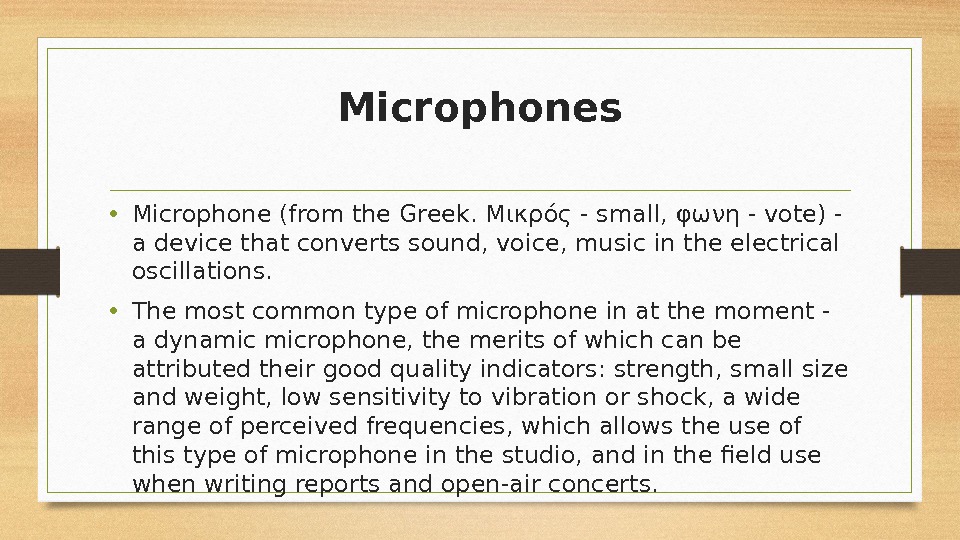
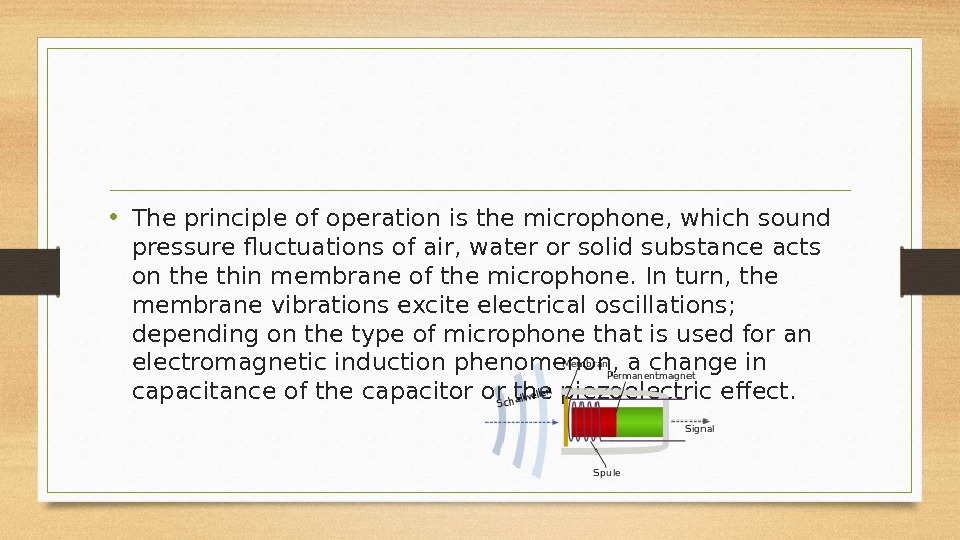
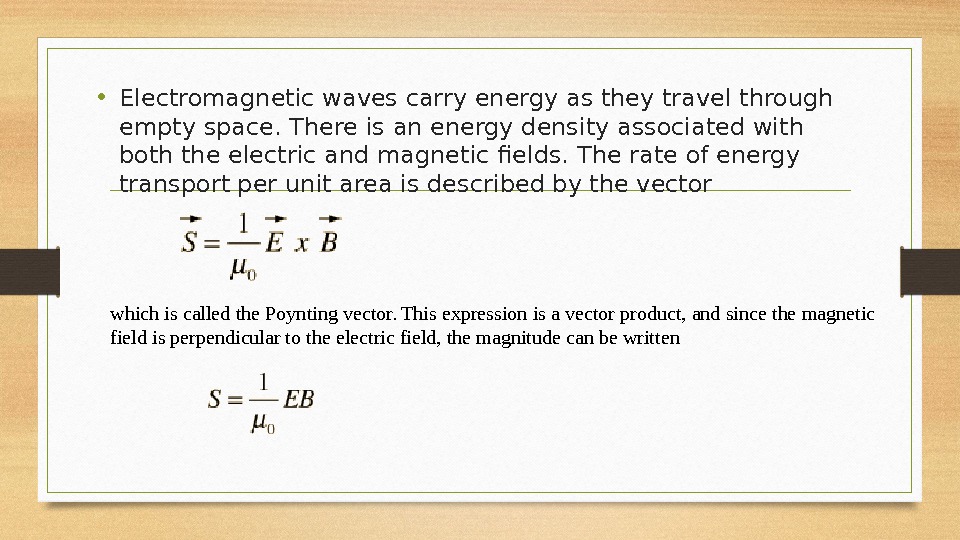
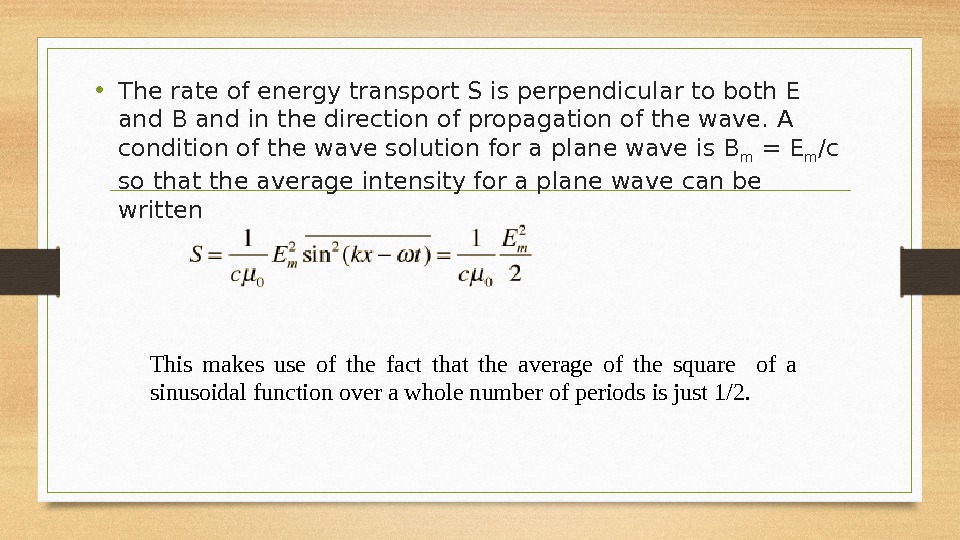
4._5_slayd.pptx
- Размер: 1.1 Мб
- Автор:
- Количество слайдов: 9
Описание презентации Electromotive Force BY Aitkul Asemgul по слайдам
 Electromotive Force BY Aitkul Asemgul
Electromotive Force BY Aitkul Asemgul
 • The electromotive force (EMF) — a scalar physical quantity that characterizes the work of external forces, ie, forces all non-electrical origin operating in quasi-stationary circuits DC or AC. In the closed circuit EMF is conducting the work of these forces on the movement of a single positive charge along the entire circuit. • Where is: A- work, • q-charge • E-EMF DIRECTION EMF intensity of external forces: understand the vector physical quantity, equal to a third party against the force acting on a test electric charge to the magnitude of this charge. Then, a closed circuit EMF equals L.
• The electromotive force (EMF) — a scalar physical quantity that characterizes the work of external forces, ie, forces all non-electrical origin operating in quasi-stationary circuits DC or AC. In the closed circuit EMF is conducting the work of these forces on the movement of a single positive charge along the entire circuit. • Where is: A- work, • q-charge • E-EMF DIRECTION EMF intensity of external forces: understand the vector physical quantity, equal to a third party against the force acting on a test electric charge to the magnitude of this charge. Then, a closed circuit EMF equals L.
 • The reason may be an electromotive force change of the magnetic field in the surrounding space. This phenomenon is called electromagnetic induction. The magnitude of induced emf in the loop is given by where : E — the magnetic flux through a closed surface S, bounded by the contour. The sign «-» before the expression shows that the induction current generated induced emf prevents the change in magnetic flux in the loop. Е
• The reason may be an electromotive force change of the magnetic field in the surrounding space. This phenomenon is called electromagnetic induction. The magnitude of induced emf in the loop is given by where : E — the magnetic flux through a closed surface S, bounded by the contour. The sign «-» before the expression shows that the induction current generated induced emf prevents the change in magnetic flux in the loop. Е
 • EMF as well as the tension in the International System of Units (SI) is measured in volts. You can talk about the electromotive force in any part of the circuit. This specific work of external forces is not around the circuit, but only at the site. EMF of the cell has a job outside the forces when moving the unit positive charge inside the cell from one pole to another. The work of external forces can not be expressed in terms of the potential difference, because outside forces nonpotential and their work depends on the shape of the trajectory. For example, the work of external forces by moving charge between the terminals of the source current is zero.
• EMF as well as the tension in the International System of Units (SI) is measured in volts. You can talk about the electromotive force in any part of the circuit. This specific work of external forces is not around the circuit, but only at the site. EMF of the cell has a job outside the forces when moving the unit positive charge inside the cell from one pole to another. The work of external forces can not be expressed in terms of the potential difference, because outside forces nonpotential and their work depends on the shape of the trajectory. For example, the work of external forces by moving charge between the terminals of the source current is zero.
 ELECTROMOTIVE FORCE TERMIN • (EMF) — a phenomenological description of the current sources. Introduced by Tom (G. Ohm) in 1827 for the post of chains. Current and picked G. Kirchhoff (G. Kirchhoff) in 1857 as the work of «outside» forces when moving the unit electric. the charge along a closed path. Then the concept of the EMF Steel interpreted more broadly — as a measure of the specific (per unit transported charge current) energy transformations carried out in quasi-stationary [see. Quasi-stationary (quasi-static) approximation] Electrical. chains not only «third-party» sources (galvanic. batteries, generators and so on. f. ), but also «stress» elements (electric motors, battery charging mode, chokes, transformers and so on. n. ).
ELECTROMOTIVE FORCE TERMIN • (EMF) — a phenomenological description of the current sources. Introduced by Tom (G. Ohm) in 1827 for the post of chains. Current and picked G. Kirchhoff (G. Kirchhoff) in 1857 as the work of «outside» forces when moving the unit electric. the charge along a closed path. Then the concept of the EMF Steel interpreted more broadly — as a measure of the specific (per unit transported charge current) energy transformations carried out in quasi-stationary [see. Quasi-stationary (quasi-static) approximation] Electrical. chains not only «third-party» sources (galvanic. batteries, generators and so on. f. ), but also «stress» elements (electric motors, battery charging mode, chokes, transformers and so on. n. ).
 Microphones • Microphone (from the Greek. Μικρός — small, φωνη — vote) — a device that converts sound, voice, music in the electrical oscillations. • The most common type of microphone in at the moment — a dynamic microphone, the merits of which can be attributed their good quality indicators: strength, small size and weight, low sensitivity to vibration or shock, a wide range of perceived frequencies, which allows the use of this type of microphone in the studio, and in the field use when writing reports and open-air concerts.
Microphones • Microphone (from the Greek. Μικρός — small, φωνη — vote) — a device that converts sound, voice, music in the electrical oscillations. • The most common type of microphone in at the moment — a dynamic microphone, the merits of which can be attributed their good quality indicators: strength, small size and weight, low sensitivity to vibration or shock, a wide range of perceived frequencies, which allows the use of this type of microphone in the studio, and in the field use when writing reports and open-air concerts.
 • The principle of operation is the microphone, which sound pressure fluctuations of air, water or solid substance acts on the thin membrane of the microphone. In turn, the membrane vibrations excite electrical oscillations; depending on the type of microphone that is used for an electromagnetic induction phenomenon, a change in capacitance of the capacitor or the piezoelectric effect.
• The principle of operation is the microphone, which sound pressure fluctuations of air, water or solid substance acts on the thin membrane of the microphone. In turn, the membrane vibrations excite electrical oscillations; depending on the type of microphone that is used for an electromagnetic induction phenomenon, a change in capacitance of the capacitor or the piezoelectric effect.
 • Electromagnetic waves carry energy as they travel through empty space. There is an energy density associated with both the electric and magnetic fields. The rate of energy transport per unit area is described by the vector which is called the Poynting vector. This expression is a vector product, and since the magnetic field is perpendicular to the electric field, the magnitude can be written
• Electromagnetic waves carry energy as they travel through empty space. There is an energy density associated with both the electric and magnetic fields. The rate of energy transport per unit area is described by the vector which is called the Poynting vector. This expression is a vector product, and since the magnetic field is perpendicular to the electric field, the magnitude can be written
 • The rate of energy transport S is perpendicular to both E and B and in the direction of propagation of the wave. A condition of the wave solution for a plane wave is B m = E m /c so that the average intensity for a plane wave can be written This makes use of the fact that the average of the square of a sinusoidal function over a whole number of periods is just 1/2.
• The rate of energy transport S is perpendicular to both E and B and in the direction of propagation of the wave. A condition of the wave solution for a plane wave is B m = E m /c so that the average intensity for a plane wave can be written This makes use of the fact that the average of the square of a sinusoidal function over a whole number of periods is just 1/2.
